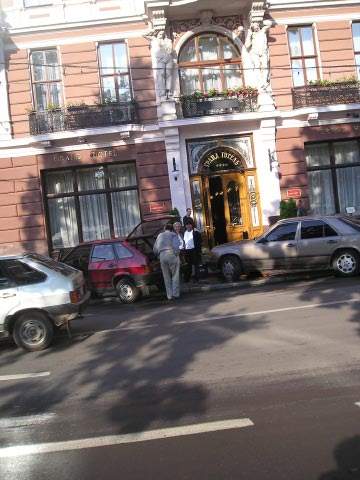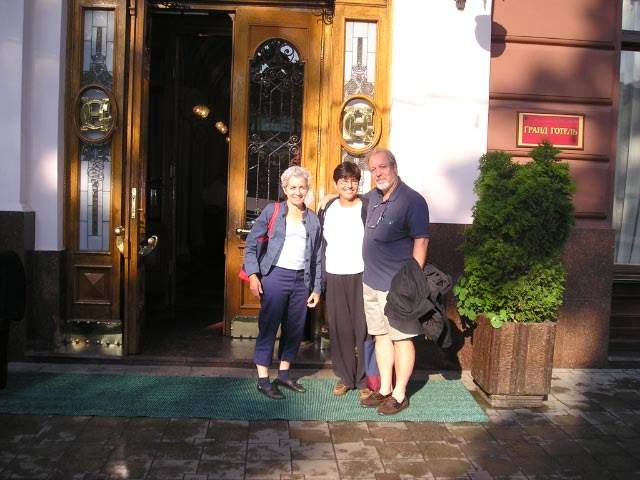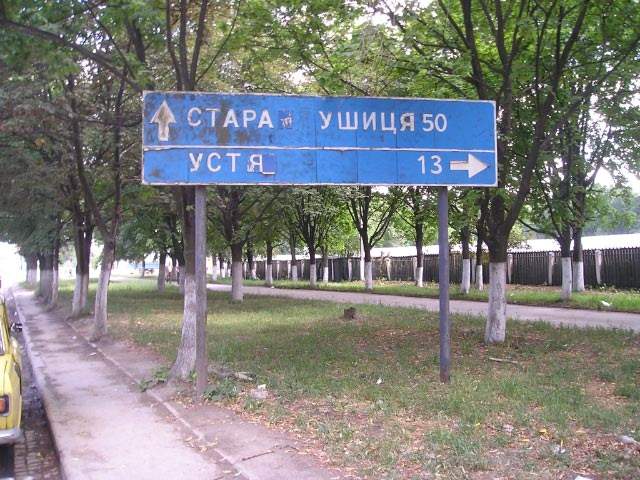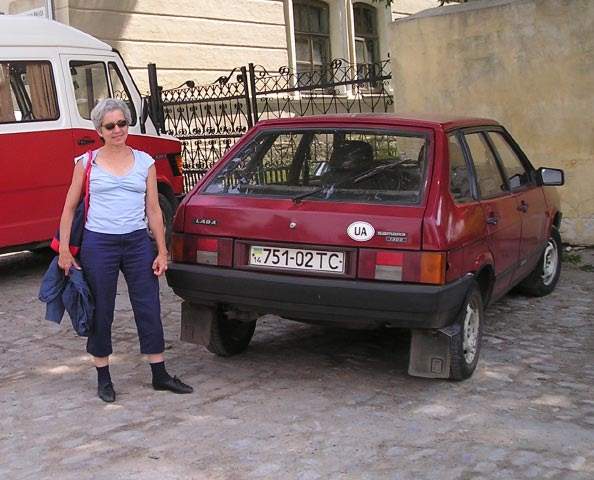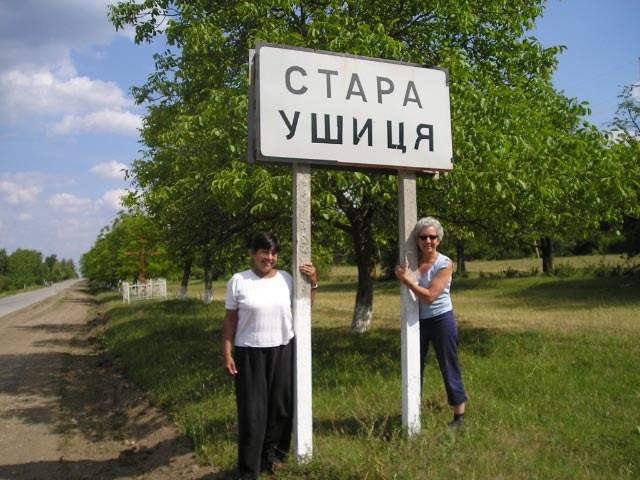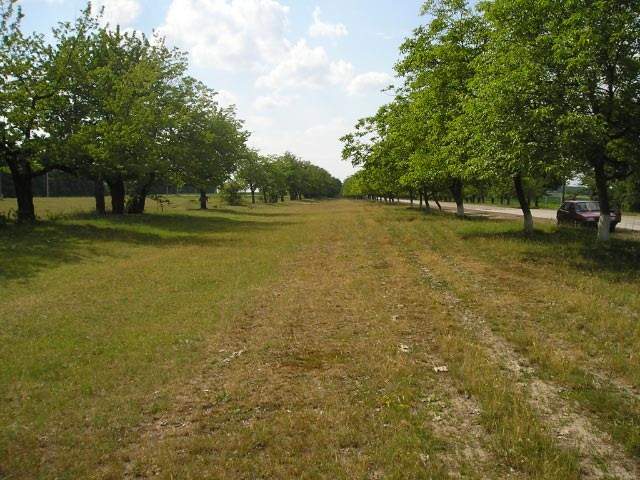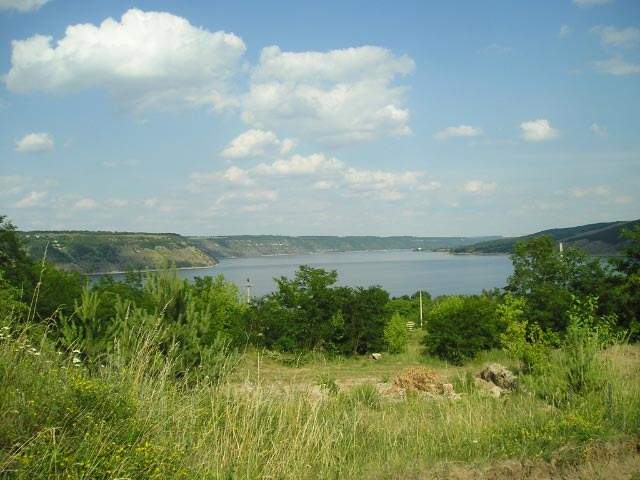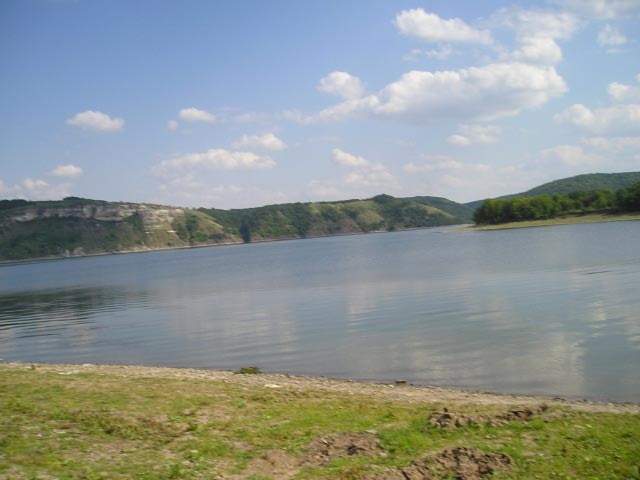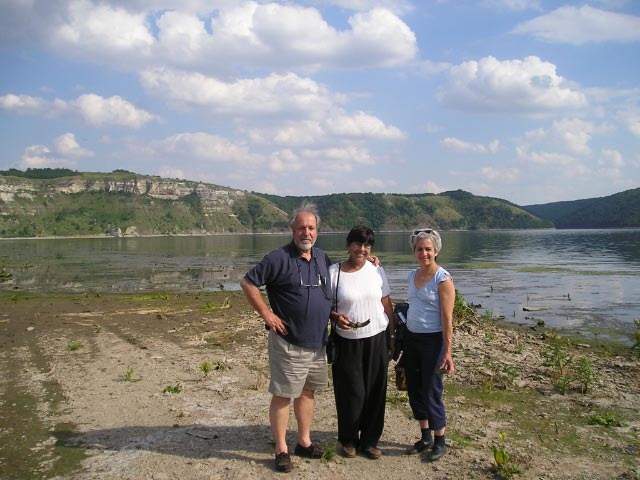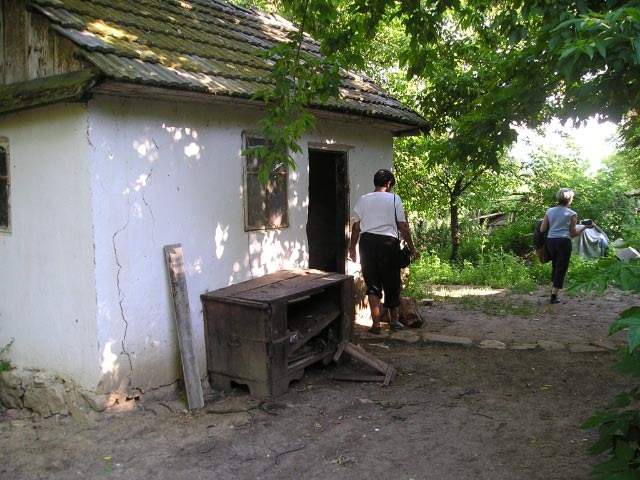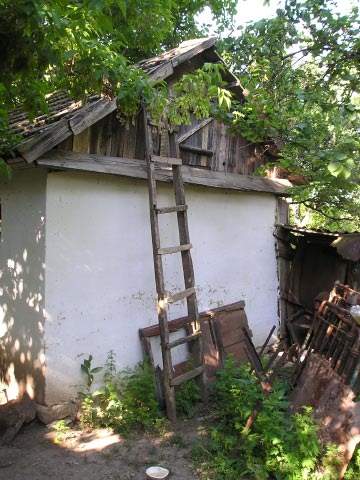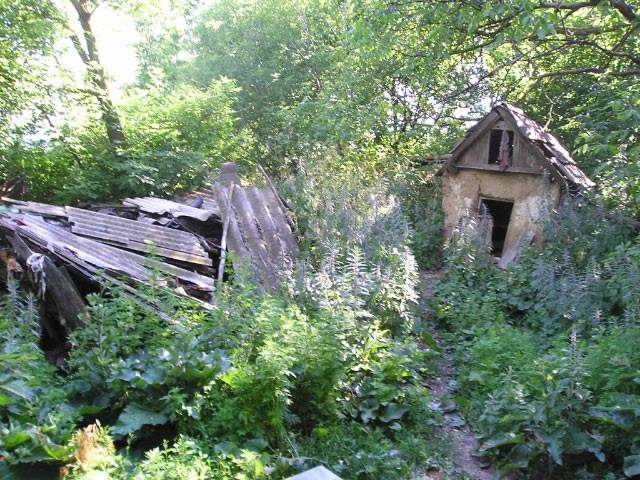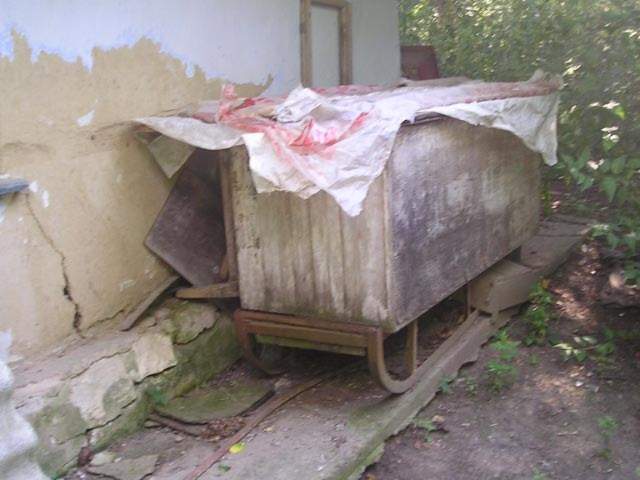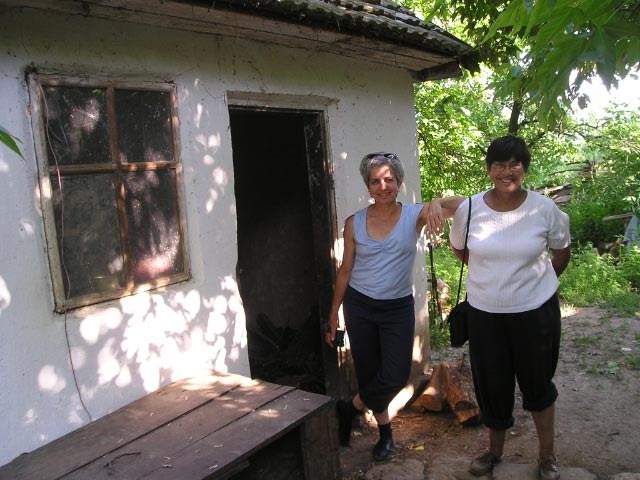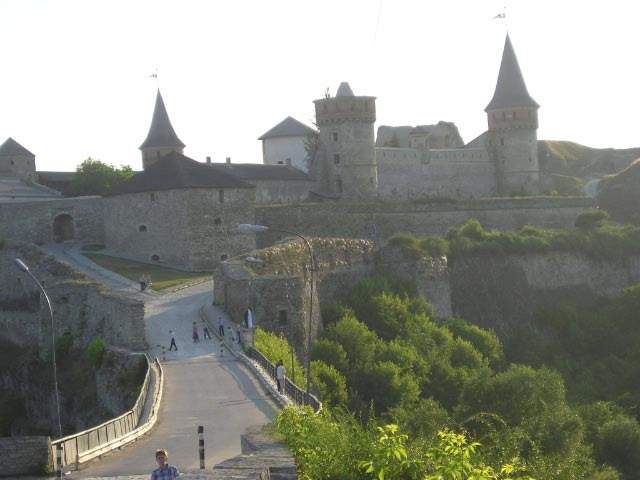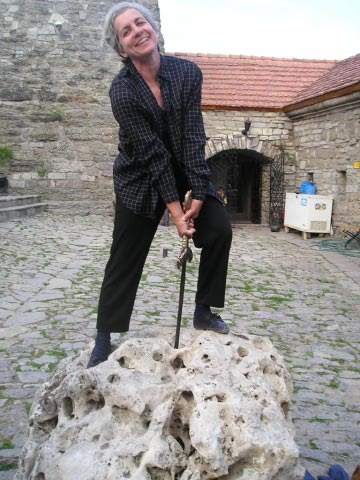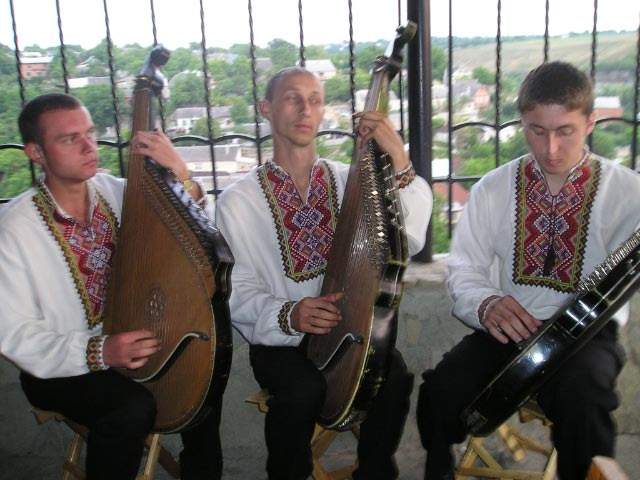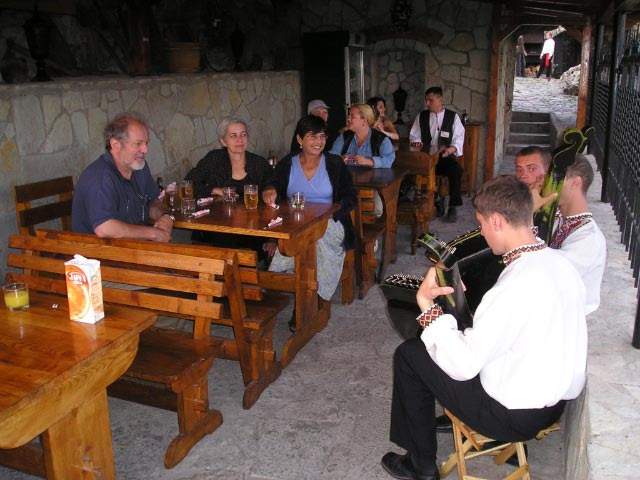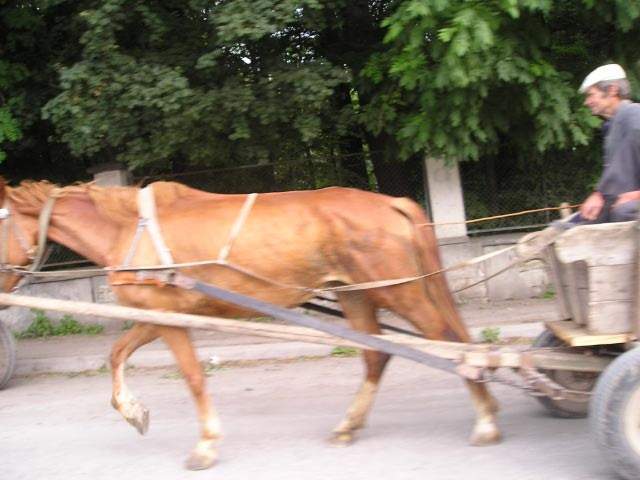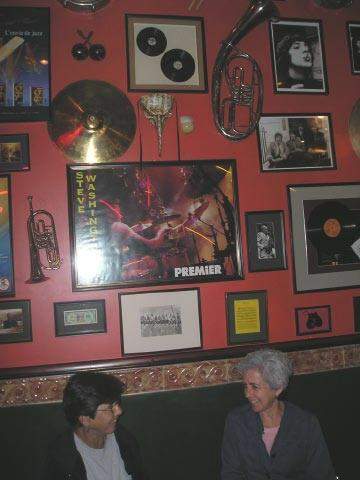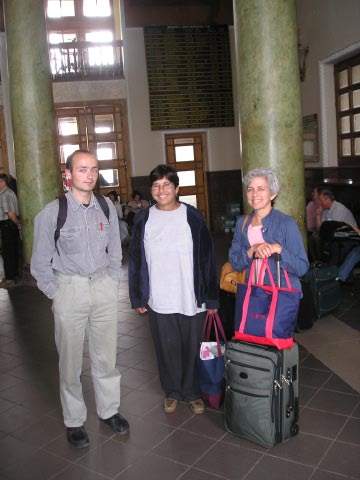Tale of Two Sisters, or Finding and Losing Stara Ushitsa
By Erol and Sue Oktay
Related to: Staraya Ushitsa (Town),
The photos Erol and Sue took on their trip are viewable at the end of the article
The story starts with a “perfect storm” of opportunity, one that we decided to seize. One factor was that my husband and I had decided to take a cruise down the lower Danube, that ended up in Romania. I knew that my father, Harry Shaberman, had been born in a town that bordered on Romania, at least it did at the time (1906). Sadly, he had passed away a year ago, so it was a fitting time to be thinking about his life and to honor his memory. This is how it all started. I thought it would be nice to pop over to visit Dad's birth town near the Romanian border, and invited my siblings to join us on the cruise, with a couple of days detour. My sister, Sue, decided to join us, and was especially interested in the “roots” part of the trip. Since I knew almost nothing about the location of the town, other than the name and that it was on the Dniester River, I began my research.
Planning and Preparation
I started on the internet, and found the Jewishgen site – a wonderful resource for anyone of Ashkenazai background searching for information on their roots. I did a search for the town, not knowing how it was spelled, and eventually found that it was currently in the Ukraine. The border was no longer the Dniester River, but perhaps 30 miles or so south. After some searching on the internet and a short visit to the YIVO center in New York, I learned that the town (Stara Ushista) had numerous spellings, depending on the language (Ukrainian, Russian or Polish). The town is in Podolia, a province in Western Ukraine, near a large town of Kamenets-Podolsky. The Jewishgen Ukrainian-SIG site had several pieces on Podolia, including a nice history written by David Bickman. There was also a horrifying description of the Holocaust in a town called Nova Ushitsa, which I thought might be the same town in a different language. (I later learned that Nova Ushitsa is near Stara Ushitsa. Stara means “old” and Nova means “new”. Ushitsa is the name of a river that intersects the Dniester.) The memoir was called, “Hard Memory: WWII Memoir” by Mikhael Borisov Eisen, who survived the holocaust, but had many relatives who did not, including his mother. His description is vivid and heartbreaking, and it made me feel glad that my family had immigrated to the US long before these events. On Stara Ushitsa, there was only a short piece that described the size and location of the town, and the status of the Jewish cemetery.
Once I learned where the town was, I began to try to arrange to get there from Bucharest. I knew that we would not find any relatives, or even anyone who remembered my father’s family. It had been too long, and almost no Jews remained in the Ukraine after WWII, and those who did survive emigrated to Israel when the borders opened up after Ukraine gained independence in the 1990’s. Our goal was not to spend a lot of time in the area, but just to see the town and the area, to smell the smells, and imagine our family’s lives in the “old country”.
I began by looking on the internet for travel agents in Romania who could advise me how best to go from Bucharest to Ukraine. This turned out to be harder than I imagined. The main problem was that I only wanted to spend a couple of days. The mileage did not seem to be great, and I tried to find out if we could drive, or take a train to Ukraine. I was not able to find information on rental cars in Romania, but the travel books suggested that to go from Bucharest to the Carpathians in the north of Romania would take about a week! Then I tried to find out about train schedules, and could only find a train that went through Moldova, taking me way east of where I wanted to go.
A Ukrainian travel agent wrote back to my email inquiry saying that what I wanted was impossible. There were no trains to that area. He informed me that when trains go from Romania to Ukraine, they have to change the carriage under the train, because the train tracks are a different gauge. I found that it would take us over 24 hours just to cross the border. The train would arrive in a town in Ukraine about 5 hours from Stara Ushitsa at 3 am. The return train would also be in the middle of the night, a couple of days later. It sounded like it would be a miserable trip!
Fortunately, I asked a colleague who had immigrated to the US from the Ukraine, and he suggested that I try flying into Lviv, a town in Western Ukraine. Using the internet, I was able to find that it was not possible to fly from Bucharest directly to Lviv, but I could fly either through Vienna or through Kiev. The flight from Vienna to Lviv goes only four times a week, but fortunately, it was possible to go on Wednesday and return on Friday. The tickets were wildly expensive, but available. This meant that we would fly from the USA to Vienna, and then directly to Lviv, and return to Vienna to start our trip.
Using the internet again, I was able to find a hotel in Lviv, and make our reservations! Now, I had to find a way to get to Stara Ushitsa! I was very appreciative that Bobby Furst and her sister had put a very detailed description of their roots trip to the Ukraine and Poland. From this, I realized that I would need a guide to drive us, and to talk with local people in the town. I contacted Bobby, and she gave me the email for their guide, Alex Dunai. Unfortunately, it turned out that Alex was not available the dates we would be there. I would need to find another guide/driver. Luckily, when I had been trying to find out about flights to Ukraine, I had come across a “bulletin board” for those traveling in Ukraine. I noticed that someone named “Slav” had responded to a question about flights, and referred the questioner to his website.
When I went to Slav’s website, I found loads of information on many aspects of travel in Western Ukraine. Just the type of information I had been seeking when I began our travel planning! In addition to describing tours involving hiking, mountain sports, etc, it was loaded with information that I could actually understand, including train schedules, flights into and out of Lvov, and it was actually in very readable English. The Lviv Ecotour agency also offered guided travel, including ancestry tours. Slav responded right away to my email, and said that he could drive us from Lviv to Stara Ushitsa, and back the next day. He said there was a hotel where we could stay overnight in Kamenets-Podolsky. I was excited, but I have to admit, I was also worried. One hears that there is a lot of crime in Ukraine, and I knew nothing about Slav, nor did I know anyone who had used his services. I began to imagine being dropped off in our little Shetl in the middle of nowhere, and being told we needed to pay an exorbitant sum to be taken back to Lviv, or worse! I didn’t know if Slav could be trusted, or if there even was a “Slav”. Perhaps the whole thing was a scheme to get information on us, so that our identity could be used for some illicit purpose.
I emailed about ten people who had used Slav's services, and quickly heard back from all of them. They were from many countries, and explained that they had used Lviv Ecotour for very different purposes, and yet everyone praised Slav, said he was trustworthy, and knowledgeable. We decided to hire Slav to serve as our driver and guide. So, we got ready for the trip. I found a wonderful book (two volumes actually) by two men who had traced family to a town in Podolia not far from Stara Ushitsa. This provided a detailed history of the area, as well as wonderful chapters on the life of the Ukrainian Jews in this area, from food, culture, music to health and religion. The authors, David Chapin and Ben Weinstock, had done extensive research, and although theirs was a different town, I learned a lot and would definitely recommend this work to anyone whose family comes from this area.
We're off!
We took a train to New York, (instead of flying directly from Washington) to get a flight that would arrive in London in time to catch a flight to Vienna that would allow us to catch the flight to Lviv. We met up with Sue, who was coming from California, at JFK airport in New York. The flights to London and Vienna went smoothly, except that British Air wouldn't allow us to take our suitcases on board. Although they were small, they weighed over the 13 pound limit. So we had to check them. This meant that we would have to go through customs and passport control in Vienna, instead of being able to transfer directly. Slav had attached a picture of his car to one of the emails, and as it looked quite small, we decided to check some of our baggage in Vienna. Fortunately, we were able to find a baggage check service in the airport. (Isn’t Europe civilized for travel!)
In Vienna, we got on a small propeller plane, and to our surprise, had a lovely flight with a really good meal – really the best food we’ve had on an airplane in many years! We arrived on time, and got through the passport control and customs in about a half hour. Lviv is a very small airport, and we took a small bus from the plane (which we deplaned on steps to the tarmac). We had to fill out immigration forms, (fortunately in English) and go through the passport control. We had to declare how much money we had, and then they asked us to actually show them the money. This didn’t feel comfortable, but… we had no choice, so we did. Then we were in the little room where the baggage was delivered. Since we had no checked baggage, we were the first ones through the door to the terminal’s central room (with a beautiful high dome in the center).
At this time, I found myself getting nervous. What would we do if Slav was not there? What if he was not able to speak English, or would tell us that we wouldn’t be able to do our trip for some reason? What a relief to find Slav right by the door, introducing himself and helping us with the luggage. Slav is a small man, with a sweet, gentle demeanor. He speaks American English with hardly any accent, and understands everything. We quickly popped into his little red Lada, and he drove us to our hotel.
Lviv
On the way, he told us some things about Lviv, and its history. Lviv was part of Poland at the beginning of World War II, and since Poland collapsed in only 10 days, there was no destruction, as there was in other Ukrainian towns (e.g. Kiev). Lviv looked like a typical European town, with cobblestone streets, narrow alleys going up and down, buildings similar to parts of Paris. By the time we got to the hotel, we also learned where to go for dinner, and where to walk around to get a brief glimpse of this lovely town. We were so tired; we just checked in and took a nap. We were at the Grand Hotel, a splurge that we thought we might need after a long day of travel. It was luxurious, and we certainly could have been fine with a less fancy place. But it was reassuring to know that we would be comfortable at least for our first night in Ukraine!
After a brief nap, we dragged ourselves up to explore Lviv and have some dinner. (We also wanted to get onto the European time.) When we left the hotel, the street was crowded with young people, and we soon saw why. There was a Ukrainian -style hip hop group performing in the square in front of the hotel. They looked just like any other rock group (to us) There was a large platform, with speakers and a huge screen projecting the image of the performers. Everyone was having a great time, dancing to the music, and singling along. They were all wearing blue jeans.
We walked up the street to the opera house, and tried to decipher the Cyrillic letters to see what was being performed. Then we wandered back on the other side of the square. Slav had told us how to get to the Amadeus restaurant, and we remembered Bobby’s account of enjoying a meal there. We set out to find it, by walking behind the church. However, there seemed to be a church in every direction! We noticed lots of “restaurants”, with outside tables, but people were not eating. They were all drinking beer and smoking! We eventually did find the Amadeus, and settled down on a pretty patio. Fortunately, the menu was in several languages, and we were able to find things we wanted to try. Our waitress was helpful when we didn’t know what things were (e.g. a kind of sour meat soup).
We ordered local beer, and had some soup, one order of Wiener Schnitzel and one order of mixed varenykys (perogies). The soup and the varenykys were especially good. After this, we returned to the hotel and were able to use their internet center to check our email and send messages to the family that we had arrived in the Ukraine.
Slav had arranged to pick us up at eight the next morning, so we were up early. We got our wake-up calls, as requested, and packed up. In the hotel dining room, we found the most extravagant buffet we have ever seen. There was a chef making crepes to order. There was caviar and lox, wonderful pastries that reminded us of Jewish delicacies, like poppy seed rolls, apple strudel, etc. There were some hot things, like egg Florentine, meats, cheese. Wonderful jams. All in all, quite a spread! I couldn’t eat much, as I was excited about the trip to come, but ended up tasting a bit of everything in spite of myself!
Slav was there before eight, and he brought with him a very detailed map of the Podolia province. He showed us the route we would take, and where Stara Ushitsa was on the map. Sure enough, it was right on the Dniester River. We were beginning to learn some of the Cyrllic letters, and could make out the sounds. We got into the car and headed out of Lviv. Shortly, we stopped to fill up the tank. We paid for the gas, as we had agreed, and it was about $2.00 a gallon, just like at home. About an hour later, we were near Ternopol, and Slav stopped at another gas station and asked if we could use the bathrooms. So we had a “rest stop”. I was relieved, as I had been worried that we wouldn’t be able to use restrooms until we got to our hotel. The bathroom was not dirty, but I was glad I had brought my little Kleenex pack along!
The roads were good - not expressways, but well repaired two lane asphalt roads. We had no traffic congestion. The roads have wide shoulders, which are used by horse carts, people walking, and sometimes, animals grazing. The roads are lined by fields, at this time of year, looking like lots of corn, potatoes, and sunflowers. (Slav explained that sunflower oil was a major export of Ukraine.) We also saw fields of poppy, and Slav said that poppy seeds were used in lots of baked goods. On the way, we stopped briefly when Slav got a phone call, and had to stop to get some information from the trunk of the car. While stopped, we noticed that the trees where we stopped full of wild cherries and walnuts. We also saw lots of fruit trees that Slav said were apples.
Kamenetz-Podilsky
We arrived in Kamenets-Podilsky around 1:00 pm. Slav had researched the hotels in town, but he had not stayed here before. He said that there was an old Soviet-style hotel, and also a couple of newer ones. He asked for directions and quickly found one of these. We went in and decided to take three rooms. Slav took a standard room, and we took two “deluxe” rooms. These turned out to be large suites, with living rooms, balcony, refrigerator (not turned on), and luxurious bathroom with huge tub. The staff did not speak English, and we were glad to have Slav to negotiate for us. (In retrospect, we would have been fine with the standard rooms, which were much cheaper.) The rooms were $50, and included breakfast.
We decided to have lunch there at the hotel café, before heading out for Stara Ushitsa. Looking at the menu, we were excited to see they offered “mamala”, because this is something that our father had brought from the “old country” and we commonly had it as a light supper. This is simple cornmeal, cooked and served with cottage cheese, butter, salt and pepper. In Kamenets-Podilsky, it was very similar: corn meal, served with butter and cheese, but the cheese had somewhat larger and harder curds than in the US. It also had a much stronger taste. On the top was a fried pork (like thick bacon, or pork rind cubes) that certainly the Jews didn’t eat! It was delicious. We also had borscht, and it was good, but not like the kind we ate at home (Maneshevitz type, cold red beet soup with sour cream). This was a hot soup, with meat stock, a variety of vegetables, including some beet, with sour cream on top.
Slav had asked some local people about the town, and learned that during the Soviet period, a dam had been built up-river from Stara Ushitsa to electrify the area. They said that the river would be much wider now than it was at the time our family lived there. After lunch, we met at the car, and looked for the road to Stara Ushitsa. Slav had to ask a few times, to find the right road. There were no road signs, but people seemed to know how to direct us, and we were soon on the way. We were able to follow along with the map, and see the various towns, rivers, railroad track as we made our way. It is about 35 miles, and we made good time, with very little traffic. The towns were very small, and we often saw nothing but a sign and a few houses. The country was very pretty; the road was windy, with some hills.
Stara Ushitsa
Before long, we came to the sign that we were in Stara Ushitsa, and we stopped and got out and took some pictures of us standing by the sign. It was very exciting to have come this far! The day was perfect – clear sky, sunny but not too warm. We followed the cobblestone road as it began to descend, at first gradually and then more steeply. We saw a few houses, but no town. As the hill got steep, we parked the car and walked on, down the cobblestone road towards the riverbank. There were some local folks there, we heard laughter, and it looked like a recreation spot. We could see people in swimming suits, and some that looked like they were camping. Slav asked where the town was, and learned that after the dam was built in the 70's, the village was flooded. A new town was built for the population, at the top of the hill. We realized that where we were standing, was probably the upper level of the old town. The town center was now under water.
We walked to the river, and I looked for some stones to bring back as souvenirs. One family story our cousin told us was that our grandfather used to go to the riverbank to find flint stones to light the household fire. So, I picked up a flint stone, as well as other common varieties. The river was low, and we walked out on a mud flat that must usually be under water. We found some old bolts, and Slav picked up some broken fragments of pots that he said must have been very old. We imagined that these could have been from our grandparents’ era, and took them with us as souvenirs. People were swimming and fishing, and Sue and I walked down and put our feet in the water. We tried to look around, and imagine the view from the old town where our grandparents once lived. We tried to memorize the look of the river, the mountains on the other side, the smells in the air, the vegetation.
While the stories we heard were very negative, about how it was a “mud hole”, with no plumbing, water, etc, we felt it was very beautiful. The air was perfumed with some flower that we couldn't identify (Linden?), the river looked quiet and peaceful, the houses were charming, with whitewashed outsides, some white, some a light blue, and others peach or beige. They were small, with several buildings in the yards. It occurred to us that perhaps one of the separate buildings was a kitchen. In our grandparents' home, they had a kitchen in the basement, and cooked there instead of in the kitchen on the main floor. Perhaps they were accustomed to cooking in a different area than the main house. We took lots of pictures of the river, and of some of the houses in the area. We talked (through Slav) to the fishermen, and they showed us their catch. They said they would eat it on top of mamaliga! We noticed lots of fishing lines in the water.
We imagined my grandfather and his brother swimming across the river… or were they on horses? We saw a small boat, with a bow that lifted up much higher than the rowboats in the US. Perhaps they used boats? (Memories rose up of Dad rowing me to a store that had a dock at one of our summer vacations cottages.) We looked at the area again, as we returned to the car. We remarked on how similar it was to Michigan, where we were raised. Many of the plants were the same – even the weeds. The general look of the land was the same, with lots of flat areas, and some rolling hills. There were cherry trees and apple trees everywhere.
One difference was that Stara Ushitsa had walnut trees, and mulberry trees, which we do not have in Michigan. We'd noticed some birds wading in the water, and thought they might be herons, but as they flew off, we realized that they were storks! We also noticed other things that we could connect to our father’s stories. For example, many of the homes had flocks of geese (perhaps six or seven). As a child, our father used to feed the geese in his home, and he would tell us how afraid of them he was, when they snapped at his legs! As we left, we noticed several people taking their goats for a walk on a leash. The goats had beautiful white fluffy coats. We thought of the Passover song, “An only kid” as we saw these goats everywhere – especially as they seemed to be always in pairs.
It might seem that we would be disappointed that the town was not there anymore, but I didn’t feel that way. I knew that the town where our grandparents lived would not be the same. Having read other accounts of people returning to their towns that they left before WWII, I knew that it wouldn’t be the same. Of course, we did not have any memories of the town as it was. So to actually be in the spot, to see and feel the area, was gratifying. It almost felt good that the town was no more. Certainly it made me feel very grateful that they had made the journey to the U.S., since we were spared the horrors of the revolution, WWI, pogroms, the exterminations of the Nazis, and finally, the impact of the Soviet system.
The Return Trip
We drove back to Kamenets-Podilsky, thinking about the family history, and that of so many other Jewish families. Looking around, seeing people traveling on horse-pulled wagons, I imagined my grandmother, with a baby and a toddler, and her Samovar, sitting on the back of such a wagon. Did she go to Kamenets-Podilsky and take a train from there to Hamburg? (I know from the ship's log that her ship left from Bremer-Haven.) What a difficult trip that must have been!
I had learned from my reading that perhaps 40% of the population was Jewish at one time. How terrible life must have been for them that so many people left behind everything they owned and everyone that they knew, to make such a long journey to an unknown land. I felt glad that they had found a place that would have been somewhat familiar to them. When we got back to Kamenets-Podilsky, Slav mentioned that there was a nice restaurant near the castle. We went over there, and only walked around the castle, since it was already closed. It is very dramatically sited. Slav explained that it was built by the Poles, to protect the area against the Ottomans. Not far is another fort, which was built by the Ottomans to defend the area from attacks during the period they were in control. The Turks were only in power in this area for about 20 years. After that, the area was Polish, part of the Austrian-Hungarian Empire, and part of Russia. This is why all of the towns have several names – one in each language.
We saw a wedding party near the castle, and they wanted to take some pictures with us, so we all posed together. In front of the restaurant was a statue. Slav said that this was a famous Cossack, who was a hero of the Ukrainians. I remembered hearing that it was the Cossacks who led the pogroms against the Jews, and thought how one group’s hero is another group’s oppressor. Afterwards, as the sun set behind the castle, we had a lovely dinner of shashlik (there was pork and fish - we chose fish), and some meat and vegetable stews. There were musicians in folk costumes, who came by and sang local ballads accompanied by a guitar-type instrument that we had never seen.
The next morning, we had breakfast at the hotel. There were three choices for breakfast, so we each had one of the options, and compared notes. Slav got a smaller breakfast, since he had the “standard” room. Everything was good, although not at all the typical American breakfast! Our only complaint was that they could make only one cup of coffee at a time, and so the coffee (espresso) came well after the breakfast!
Back to Lviv
Once again, we left early, to be sure to return to Lviv in time for our flight. We made very good time once again, and arrived in Lviv in plenty of time. On the way, we admired the horse carts, and speculated on how American tourists might enjoy a countryside trip where some of the travel was in these carts, or even, learning to drive them. We noticed little tables with jars of raspberries by the road, and Sue and I wanted to buy some. Since we didn’t have our own container, we had to buy the whole jar, and we munched delicious raspberries all through the trip. Slav mentioned that he had seen a dictionary of American slang, and he noticed that many of the Yiddish words are the same as Ukrainian ones. We identified “schmatta” (rag) as Ukrainian, and enjoyed identifying other common expressions and superstitions (evil eye).
When we got to Lviv, Slav suggested that he take us up to a castle, where we could see the whole town, and he could orient us to Lviv and its history and major sites. I wanted to see if I could find a picture (painting) that looked like the Stara Ushista area, and Slav said there was an arts and crafts type market in town. We decided to have lunch at a café near the market. Slav took us to the Jazz café – a nice little spot that has jazz in the evenings, and all sorts of jazz paraphernalia on the walls, including pictures of New York! We had simple cheese sandwiches and salads. Once again, the menu was available in English, so we had no trouble with it. There were a number of Mexican or Latin type dishes, and we thought that was strange, especially for Sue, who comes from California!
We ended up spending so much time wandering about in the market, that we didn’t have time for trip to the Lviv castle. We bought all kinds of things, but I did not find a painting that really captured the essence of Stara Ushitsa. I did like one large painting, and we considered having Slav send it to us, but he was concerned that the customs sometimes does not allow art work to leave the country. So, we bought some souvenirs, and enjoyed looking at everything. At one stand with antiques, we saw a Samovar that looked very much like the one my grandparents brought over. I would have bought it, but it would have been impossible to carry!
The trip back to Vienna went smoothly. We went quickly though passport control, presenting our forms, and accounting for how much money we'd spent. That was it. We watched a women who had brought some art work getting a very thorough search by the inspectors at the airport, and were once again appreciative of Slav’s advice. Our flight was late coming in from Vienna, and so we were late leaving, but had another lovely meal with real china and silverware, and had no problem picking up our things in Vienna.
Afterthoughts
Although we went through a lot of hassle and expense to get to Stara Ushitsa, we were very happy that we went. We leaned so much about the history of the area, and it was very special to be able to see it, and make it all real. We also saw not just the huge break with the past that our grandparents took, but also saw lots of continuity. The foods they ate were much like those of the Ukraine, with mamaliga, smoked fish, bagel and lox, served with capers and chopped onions, poppy seed and apple cakes, cabbage rolls, and borscht with sour cream. In Cleveland, the family had geese, chickens, a garden, and a horse that pulled a cart, much as they must have had in Stara Ushitsa. Also, the way the home was decorated, with lace curtains and table cloths, all the sweaters and scarves my grandmother knitted, and even the rubber tree in the living room – just like we saw everywhere in the Ukraine. Even the rolls my Dad used to bake, with a crisp crust, but chewy on the inside, were everywhere in Ukraine and (as we learned later) Romania.
Note on our guide, Slav
So much of the success of our trip depended on Slav. We are so grateful to him. He was a terrific guide. Slav’s knowledge is extensive, and now that I have visited some of the nearby countries, I realize how well-educated he is, and how broad his view. Many of the guides in other eastern European countries are still very nationalistic, and chauvinistic. History was often presented as how bad everyone else has been to them, and how wonderful they are. In comparison, Slav was very well-educated. For example, he had mentioned a book that theorizes that the next big struggle in the world will be along religious lines, and the line between Roman Catholic Europe and Orthodox runs right down the middle of Ukraine. On the plane back to Vienna, the Harold Tribune had an article on that very book!
Slav’s English is also so good. I appreciate it more, after going around with other guides, who are so difficult to understand! With Slav, we were able to be very relaxed and there was no strain, with his language or with his views. There were only a few times when Slav didn’t understand something we said. In one conversation, we used the word “switchback” and this was a new term to him. At another point, Sue and I were talking about different types of berries, and we mentioned boysenberries. After a polite pause, Slav asked if we were talking about “poison berries”! When we were ordering dinner, we asked what type of fish was in the shashlick, and he didn’t know the word for catfish, but said “the fish with whiskers”.
We had heard that there was still a lot of anti-Semitism in the Ukraine, and had worried about how we would be received. Slav told us that many of his customers are Jewish, doing trips like we were. He was curious as to why so many of the American visitors to Ukraine are Jewish, but we saw no trace of anti-Semitism. In fact, Slav mentioned that his Jewish friends had moved to Israel, and he has visited them there.
Images of Stara Ushistra
These photos were taken by Erol and Sue Oktay, on their trip to Vienna, Lviv, Kamenetz-Podilsky and ultimately, Stara Ushistra
